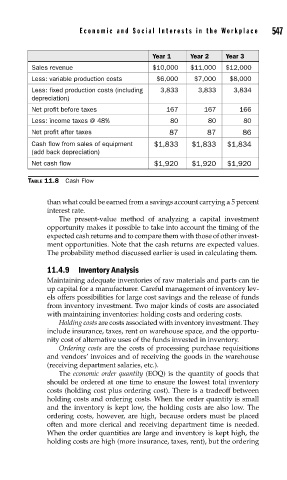Page 594 - Sensors and Control Systems in Manufacturing
P. 594
Economic and Social Inter ests in the Workplace
Year 1 Year 2 Year 3 547
Sales revenue $10,000 $11,000 $12,000
Less: variable production costs $6,000 $7,000 $8,000
Less: fixed production costs (including 3,833 3,833 3,834
depreciation)
Net profit before taxes 167 167 166
Less: income taxes @ 48% 80 80 80
Net profit after taxes 87 87 86
Cash flow from sales of equipment $1,833 $1,833 $1,834
(add back depreciation)
Net cash flow $1,920 $1,920 $1,920
TABLE 11.8 Cash Flow
than what could be earned from a savings account carrying a 5 percent
interest rate.
The present-value method of analyzing a capital investment
opportunity makes it possible to take into account the timing of the
expected cash returns and to compare them with those of other invest-
ment opportunities. Note that the cash returns are expected values.
The probability method discussed earlier is used in calculating them.
11.4.9 Inventory Analysis
Maintaining adequate inventories of raw materials and parts can tie
up capital for a manufacturer. Careful management of inventory lev-
els offers possibilities for large cost savings and the release of funds
from inventory investment. Two major kinds of costs are associated
with maintaining inventories: holding costs and ordering costs.
Holding costs are costs associated with inventory investment. They
include insurance, taxes, rent on warehouse space, and the opportu-
nity cost of alternative uses of the funds invested in inventory.
Ordering costs are the costs of processing purchase requisitions
and vendors’ invoices and of receiving the goods in the warehouse
(receiving department salaries, etc.).
The economic order quantity (EOQ) is the quantity of goods that
should be ordered at one time to ensure the lowest total inventory
costs (holding cost plus ordering cost). There is a tradeoff between
holding costs and ordering costs. When the order quantity is small
and the inventory is kept low, the holding costs are also low. The
ordering costs, however, are high, because orders must be placed
often and more clerical and receiving department time is needed.
When the order quantities are large and inventory is kept high, the
holding costs are high (more insurance, taxes, rent), but the ordering

